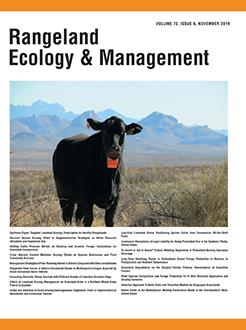Rising temperatures and more frequent droughts are posing new challenges to range livestock producers in the southwestern United States and many other parts of the world. We analyzed a 52-yr time series (1967–2018) of precipitation, ambient temperature, and perennial grass production (PGP), as well as 14 yr (2001–2014) of Moderate Resolution Imaging Spectrometer (MODIS)-derived vegetation phenometrics at a site in the Chihuahuan Desert of New Mexico. PGP was positively associated with December through September precipitation (r = 0.69; P < 0.01) but negatively associated with spring and summer (May–September) maximum average ambient temperature (r = –0.47; P < 0.01). PGP decreased by 43% in the second (1993–2018) compared with the first half (1967–1992) of our study (165 vs. 94 kg dry matter • ha–1; P < 0.01). Precipitation was lower and more erratic in the second half of the time series, decreasing by 18.6% (265.2 ± 15.0 vs. 215.8 ± 15.8 mm; P = 0.01). Conversely, mean maximum and mean ambient temperatures were higher during the 1993–2018 period (max T: 24.5 ± 0.1 vs. 25.3 ± 0.1°C; P < 0.01; mean T:14.4 ± 0.1 vs. 15.3 ± 0.2°C; P < 0.01). MODIS-derived Normalized Difference Vegetation Index (NDVI) analysis showed that growing seasons began and ended later and became shorter (P < 0.05) over the 14 yr analyzed. During this period, increasing maximum spring and summer (May–September) ambient temperatures were associated with decreasing growing season NDVI values (P < 0.01). Over the 52-yr study period, Chihuahuan Desert rangelands at our research site lost 43% of grazing capacity based on PGP. Nine drought yr occurred in the second half of our study compared with 2 yr in the first half. Our research supports predictions by climate scientists that higher temperatures, more frequent droughts, and lower, as well as more erratic, precipitation will adversely impact grazing capacity of rangelands in the southwestern United States.
How to translate text using browser tools
14 November 2019
Long-Term Declining Trends in Chihuahuan Desert Forage Production in Relation to Precipitation and Ambient Temperature
Matthew M. McIntosh,
Jerry L. Holechek,
Sheri A. Spiegal,
Andrés F. Cibils,
Richard E. Estell
ACCESS THE FULL ARTICLE
climate change
forage
grazing capacity
NDVI
phenometrics





